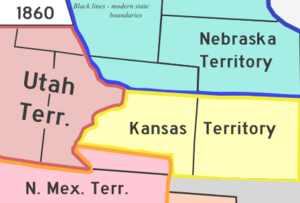25th meridian west from Washington facts for kids

The 25th meridian of longitude west from Washington is an imaginary line that runs north and south around the Earth. It is about 102.05 degrees west of the Prime Meridian in Greenwich, England. In the United States, this special line helps define the borders of several states. It forms the eastern border of Colorado and the western border of Kansas. It also marks the western border of Nebraska south of the 41st parallel north.
Contents
How State Borders Were Set
The Creation of Kansas and Colorado
On January 1, 1861, a law was passed that made Kansas a state. This law stated that the western border of the new state would be the 25th meridian west from Washington. This meant that the western part of the Kansas Territory was no longer organized.
Just thirty days later, on February 28, 1861, another law created the Colorado Territory. This law set the eastern border of Colorado as the same 25th meridian west from Washington. Because of Colorado's creation, the western border of the Nebraska Territory south of the 41st parallel north also moved east to this meridian.
When States Joined the Union
These borders along the 25th meridian west from Washington stayed the same when Nebraska became a state on March 1, 1867. They also remained unchanged when Colorado joined the United States on August 1, 1876.
Understanding Longitude in the United States
Finding Your Place on Earth
Latitude and longitude are like coordinates that tell you the exact location of any spot on Earth. Latitude is easier to figure out using observations of the sun or stars. You can do this on land or at sea, as long as the sky is clear.
Longitude, however, is trickier. It requires not only looking at the sun or stars but also having a very accurate way to tell time. This timekeeping device needs to be set to a specific reference point. In 1761, a man named John Harrison created the first very precise clock for ships, called a marine chronometer.
The Role of the Telegraph
The invention of the telegraph changed how people could figure out longitude. On May 24, 1844, the first telegraph line in North America was completed between Washington, D.C. and Baltimore. This new technology could send time signals almost at the speed of light.
On September 28, 1850, the United States officially started using two main meridians for longitude. The Greenwich Meridian (which goes through the old Royal Observatory in Greenwich, England) was used for all sea travel and international purposes. The Washington Meridian (which went through the old United States Naval Observatory in Washington, D.C.) was used for more accurate astronomy and for things within the country.
When the first telegraph line crossed all of North America on October 24, 1861, it became possible to send time signals from the Naval Observatory in Washington, D.C., all the way across the continent.
Shifting to the Greenwich Meridian
The United States used the Washington Meridian as its main longitude reference for most of the states and territories created between 1861 and 1868.
On July 28, 1866, the first permanent transatlantic telegraph cable was finished. This cable allowed the Naval Observatory in Washington, D.C., to be perfectly in sync with the Royal Observatory in Greenwich. Because of this, the need for a separate national meridian for the United States slowly disappeared.
In 1884, U.S. President Chester A. Arthur called for a meeting called the International Meridian Conference in Washington, D.C. At this conference, the meridian passing through the Royal Observatory at Greenwich was chosen as the international Prime Meridian. Finally, on August 12, 1912, the United States officially adopted the Prime Meridian of Greenwich for all uses, both within the country and internationally.

